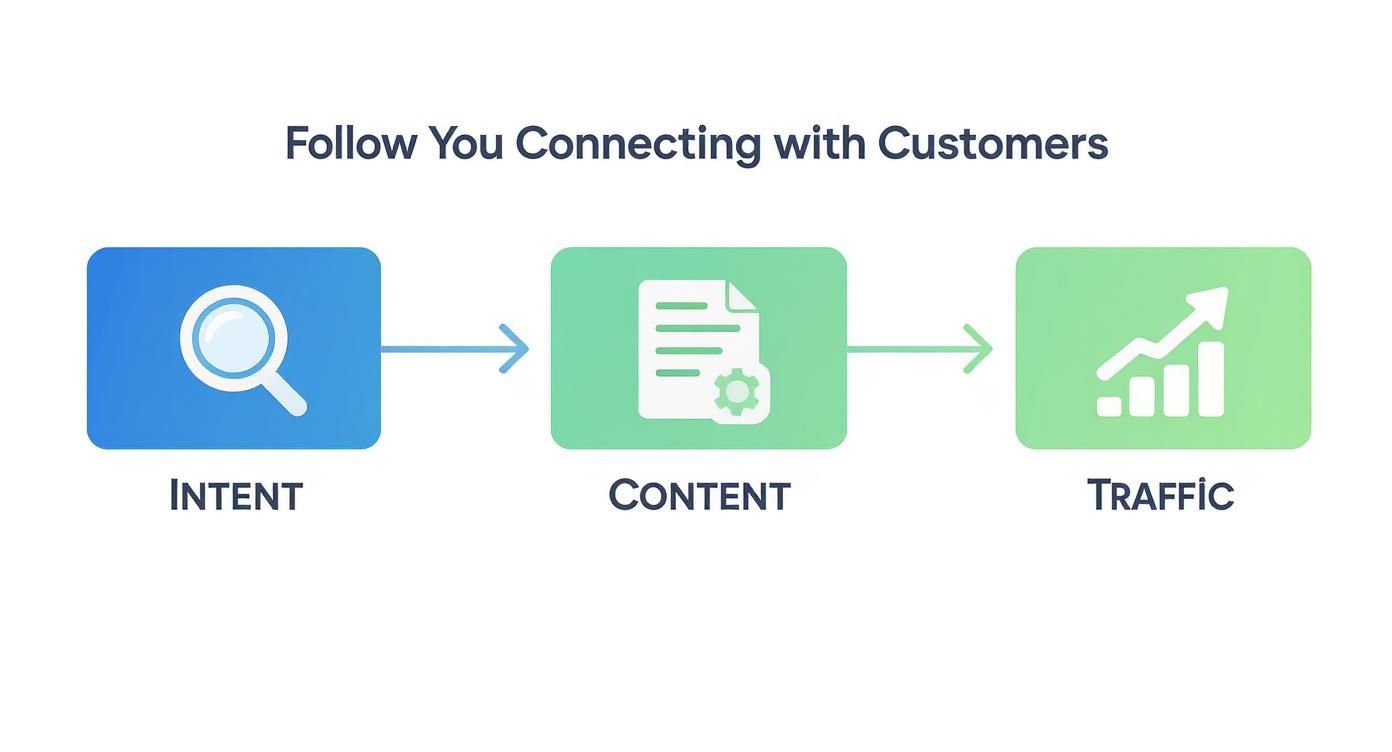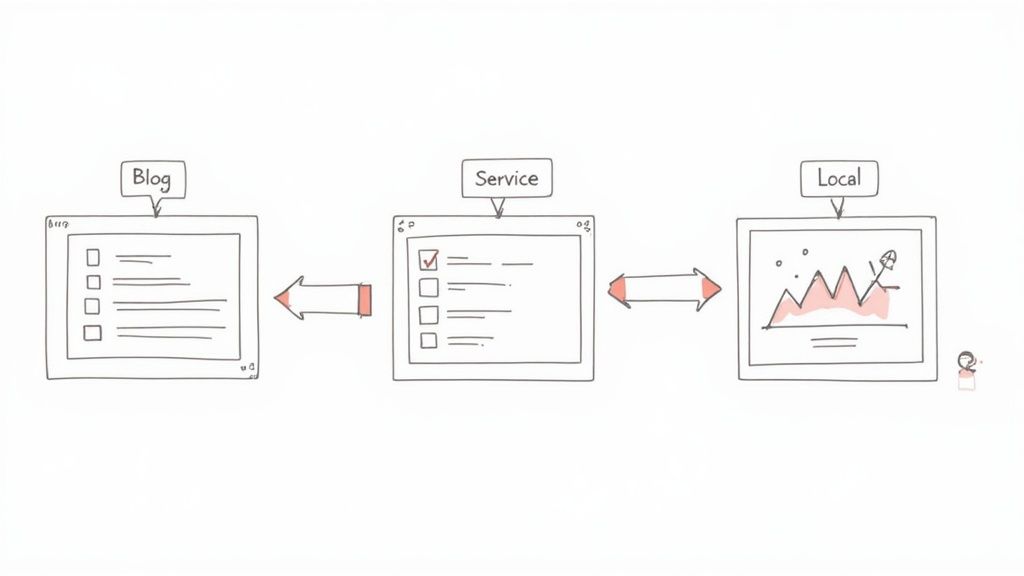Keyword Research for Small Business A Practical Guide

Effective keyword research for a small business isn't about chasing the biggest, most popular search terms.It’s the art of finding the exact words and phrases your ideal customers are typing into Google to find what you sell. Forget vanity metrics. The real goal is to zero in on high-intent, low-competition keywords that bring qualified traffic to your digital doorstep and actually grow your business.
This isn't about gaming the system; it's about making sure your budget and effort are laser-focused on reaching people who are already looking for you.
Why Keyword Research Is Your Small Business Superpower
A lot of small business owners I talk to see keyword research as some kind of dark art, a technical chore best left to expensive SEO agencies. But honestly? It's one of the most powerful tools you have in your marketing arsenal. We're not just talking about getting more website visitors; we're talking about getting the right visitors.
This process gives you a direct line into the minds of your potential customers. It shows you their needs, their burning questions, and their biggest pain points—all in their own words.
Once you understand how people search, you can stop guessing and start making decisions backed by real data. This insight shapes everything from the services you offer to the blog posts you write, guaranteeing your message lands with an audience that's ready to listen.
Understand What Your Customers Really Want
At its heart, keyword research is all about figuring out search intent—the "why" behind someone's Google search. When your content matches their intent, you meet them at the perfect moment in their buying journey.
It really boils down to three main types of intent:
- Informational Intent: Someone's looking for an answer. Think "how to fix a leaky faucet" or "what are the benefits of a standing desk." This is your chance to shine with helpful blog posts, guides, and how-to articles that build trust.
- Navigational Intent: The searcher knows where they want to go. They might type "Unkoa Marketing blog" or "login to my bank account." This isn't where you'll find new customers, so it’s less of a focus.
- Transactional Intent: This is the money-maker. The user is ready to buy or take action. Searches like "emergency plumber near me" or "buy ergonomic office chair" scream commercial intent. Your service and product pages need to be all over these terms.
By building your content strategy around these different intents, you create a complete online presence that helps customers at every single stage. Good keyword research for your small business ensures you're not just visible—you're genuinely valuable.
Drive High-Quality Traffic Without a Huge Budget
When you're running a small business, every dollar counts. Instead of blowing your budget on broad ad campaigns that hit a mostly uninterested audience, keyword research lets you be incredibly precise. By focusing on niche, long-tail keywords (those longer, super-specific phrases), you can attract people who are much, much closer to making a purchase.
Organic search drives an incredible 53% of all website visits for small businesses, making it the single largest source of traffic—beating social media, referrals, and direct visits combined. And since 75% of users never click past the first page of Google, showing up there is critical. The #1 spot alone gets an average click-through rate of 28.5%. You can dig deeper into these small business SEO insights to see the full picture.
This simple chart breaks down how it all connects, from understanding what your customer wants to getting them on your site.

As you can see, figuring out user intent is the foundational step. It dictates the kind of content you create, which in turn attracts targeted traffic. When these pieces click into place, you've built a reliable, cost-effective growth engine. This is especially true for local shops, where a solid local marketing strategy is built on understanding what people in your neighborhood are searching for right now.
How to Build Your Initial Keyword Idea List
Before you even think about touching a fancy SEO tool, every solid keyword strategy starts with a simple, creative exercise. We're going to build your "seed list."
Think of this as the raw clay you'll sculpt later on. It’s a foundational collection of core topics, phrases, and questions that relate directly to what you sell and the problems you solve for your customers.
The goal here is to get out of your own head and step directly into your customer's shoes. Forget the industry jargon for a second. What words would a real person type into Google when they need exactly what you offer? This brainstorming phase is what grounds your entire strategy in reality.

Start With What You Already Know
The best place to start is inward. You and your team are sitting on a goldmine of customer knowledge. All you need to do is get those ideas out of your head and onto a page.
Fire up a simple spreadsheet or a doc in a tool like Notion and start jotting down answers to these prompts:
- Your Services or Products: List every single thing you sell. Be brutally specific. Don't just write "marketing services." Instead, list out "local SEO for plumbers" or "social media content for restaurants."
- Customer Pain Points: What specific problem sends people looking for you? Think about their frustrations. Maybe it's "my website gets no traffic" or "how to find new sales leads."
- Your Target Audience: Who are you really selling to? Get specific with their titles or roles. Are they "small business owners," "solo founders," or "local shop managers"? Each of these groups searches differently.
This is a pure brain dump. Don't filter, don't second-guess, and definitely don't worry about perfection. Just get it all down.
Ethically Spy on Your Competitors
Guess what? Your competitors have already done some of this homework for you. Digging into their websites is a fantastic shortcut to expand your list and see how they talk to your potential customers. You're not looking to copy them, but to spot patterns and find opportunities they've missed.
Here’s a quick-and-dirty process:
- Identify 3-5 Competitors: Grab a mix of your direct local rivals and a couple of the bigger, well-known players in your space.
- Analyze Their Website Structure: Just look at their main menu. The labels they use for their services, product categories, and even their blog are often built around the keywords they want to rank for.
- Read Their Page Titles and Headings: Pay close attention to the big text on their most important pages (the H1 and H2 headings). This is where they almost always plant their primary keywords.
This quick look-see will almost certainly uncover terms you hadn't thought of and give you a feel for how others are positioning themselves.
Pro Tip: Don't just look at what your competitors are doing—look for what they aren't. If you notice a specific service you offer isn't really highlighted on their sites, that could be a keyword gap you can swoop in and dominate.
Use Google’s Free Built-In Tools
It might sound obvious, but Google itself is one of the best free keyword tools out there. It’s literally designed to predict what users are looking for, and you can use that to your advantage.
These features are powered by billions of real user searches.
- Google Autocomplete: Start typing one of your seed keywords into the Google search bar. The suggestions that pop up aren't random; they're popular, related queries people are actively searching for right now.
- People Also Ask (PAA): Search for one of your terms and look for the "People Also Ask" box. This is an absolute goldmine of question-based keywords, which are perfect for blog post and FAQ ideas.
- Related Searches: Scroll all the way to the bottom of the search results page. That "Related Searches" list gives you another eight to ten closely related phrases to explore.
By pulling these three simple, free methods together, you can quickly build a really solid seed list with dozens—if not hundreds—of potential keywords. This list is the perfect launchpad for the next step, where we'll start adding data to find the real winners.
Uncovering Hidden Gems with Budget-Friendly Tools
Alright, you've got your starting list of keyword ideas. Now it's time to stop guessing and start getting real data behind those hunches. This is where we move from brainstorming to building a data-backed strategy.
You don’t need some crazy enterprise-level budget to find powerful insights. In fact, some of the best tools for keyword research for a small business are totally free. The game here is to validate your gut feelings, find brand-new opportunities, and get a clear picture of what people are actually searching for.
The goal is to build a simple workflow, layering data from different places to see the whole picture. One tool gives you search volume, another tells you the exact questions your customers are asking. When you combine them, you find those low-competition, high-value keywords your bigger competitors are probably sleeping on.

Establish a Baseline with Google Keyword Planner
First stop: Google Keyword Planner. This is Google's own tool, and it's the perfect place to put some hard numbers to your seed list. It’s built for advertisers, but it’s invaluable for SEO, even if you never spend a penny on ads.
You’ll need a Google account to get in. It might try to push you into setting up an ad campaign, but just look for the option to "create an account without a campaign" to skip that part. Once you're in, head over to the "Discover new keywords" feature.
Here’s how to put it to work:
- Get Search Volume and Forecasts: Pop in a few of your main seed keywords. Google will spit back a monthly search volume range (like 1K-10K) and a whole list of related ideas.
- Gauge Competition: Pay attention to the "Competition" column (Low, Medium, High). This is for ad competition, but it's a great proxy for organic difficulty. "Low" often means fewer businesses are bidding on the term, which can be a signal that it’s easier to rank for organically.
This tool is your first critical filter. That keyword you thought was a slam dunk might get almost no searches. Keyword Planner lets you cross it off the list fast and focus your energy on what matters.
Uncover Customer Questions with AnswerThePublic
While Keyword Planner tells you what people search for, AnswerThePublic tells you why. This tool is brilliant. It takes your topic and visualizes all the questions people are asking around it—the who, what, where, why, and how.
Just type in a broad topic, say "home office setup," and watch it generate a web of questions and phrases.
AnswerThePublic is a goldmine for content ideas. When you see a question like "how to organize a small home office," you've just found the perfect title for a blog post that directly meets a user's need. This is how you move from broad topics to specific, intent-driven content.
It breaks down the results into helpful categories like questions, prepositions, and comparisons ("home office setup vs dining table"). This is perfect for digging up long-tail keywords that are way less competitive and usually signal someone who's deeper in the research funnel.
Spot Seasonal and Emerging Trends with Google Trends
Not all keywords are created equal year-round. A landscaping company is going to see "lawn care services" blow up in the spring, while an accountant will get a rush for "small business tax prep" early in the year. Google Trends is how you figure this timing out.
You can compare a few keywords to see their popularity over time. This helps you plan your content calendar so you’re publishing articles right before interest starts to climb. It's also fantastic for spotting breakout topics—those new, buzzy search terms your competitors haven't found yet.
Analyze Top-Ranking Content with Frase
Okay, so you've found a promising keyword. What does it actually take to rank for it? That's where a tool like Frase shines. It automates the tedious work of analyzing the top search results to show you exactly what they have in common.
The free version is powerful enough to get you started. Run a few reports and you’ll instantly see:
- Common Topics: Frase pinpoints the key topics and related phrases that the top-ranking pages all talk about.
- Average Word Count: You get a clear benchmark for how deep your content needs to be to even have a shot.
- Question Analysis: It pulls in questions from Google's "People Also Ask" boxes and forums like Reddit, giving you an instant outline for a killer FAQ section.
Using this data helps you write content that isn’t just relevant—it's genuinely comprehensive. You can see a full breakdown of how to take this info and turn it into a draft in our Frase review and workflow guide.
By combining these free and low-cost tools, you create a professional-grade workflow without the hefty price tag. This is how you find and prioritize the keywords that will actually make a difference for your business.
How to Prioritize Keywords for Real Impact
Alright, so you’ve done the legwork and now you're staring at a spreadsheet packed with keyword ideas. It might feel like a win, but let's be honest—a massive, unfiltered list is more overwhelming than it is useful. The real magic in keyword research for small business isn't just about finding keywords; it's about knowing which ones to go after first.
Prioritization is what turns a scattered content strategy into a focused growth engine. It’s all about sifting through the noise to find the quick wins that can drive traffic now and the strategic, long-term targets that will build your authority over time. This is how a simple list becomes a genuine plan of attack.
The goal isn't to rank for everything. It's to rank for the right things—the keywords that bring people to your site who are actually looking for what you offer.
A Simple Framework for Keyword Evaluation
To cut through the chaos, you need a straightforward system for scoring your keywords. Forget getting lost in dozens of complex metrics. For a small business, we're going to zero in on three critical factors. Think of them as the three legs of a stool; if one is missing, your whole strategy gets wobbly.
You’ll want to evaluate each keyword against these three criteria:
- Relevance: How directly does this keyword connect to a product or service you sell? A term like "local coffee shop with wifi" is a perfect 10 for a café, but maybe a 1 for a roaster that only sells beans online. Be brutally honest with yourself here.
- Authority: Can you realistically rank for this keyword right now? Do a quick search. If the entire first page is dominated by huge national brands, your chances are slim to none. But if it’s filled with other small businesses, forum posts, and outdated blogs? You’ve got a real shot.
- Volume: Is anyone actually searching for this? Use the free tools we talked about to get a baseline search volume. A keyword can be perfectly relevant and easy to rank for, but if only five people a month are looking for it, it’s not a priority.
By scoring each keyword on a simple 1-5 scale for each of these factors, you can quickly sort your spreadsheet and see which terms bubble up to the top. This simple act transforms a jumble of ideas into a clear, prioritized roadmap.
Your Secret Weapon: Long-Tail Keywords
For a small business, trying to compete with industry giants for broad, high-volume keywords like "office chairs" is a losing battle. They have bigger budgets, more authority, and a decade's head start on content.
But you have a secret weapon they often ignore: long-tail keywords.
These are longer, more specific search phrases that signal a user is much, much closer to making a decision. Think "ergonomic office chair for back pain under $300" instead of just "office chairs." While the search volume for each individual long-tail term is lower, the user's intent is crystal clear and incredibly valuable.
Long-tail keywords now account for a staggering 70% of all search traffic. While those big, flashy head terms are tempting, the top five organic results capture 69% of all clicks, making them extraordinarily competitive. You can discover more insights about how small businesses can win with SEO and take advantage of this trend.
Targeting these super-specific phrases lets you sidestep the heavy competition and attract highly qualified traffic that is far more likely to convert.
Creating a Simple Scoring System
Let's make this practical. Open your keyword spreadsheet and add three new columns: Relevance (1-5), Authority (1-5), and Volume (1-5). Now, just go through your list and assign a score to each keyword for all three categories.
Here’s what that might look like for a local roofer:
| Keyword | Relevance | Authority | Volume | Total Score |
|---|---|---|---|---|
| "roof repair" | 5 | 1 | 5 | 11 |
| "emergency roof leak repair near me" | 5 | 4 | 3 | 12 |
| "cost to replace asphalt shingle roof" | 4 | 5 | 4 | 13 |
See what happened? The broad term "roof repair" scores poorly on authority because it's just too competitive. The long-tail keywords, however, represent a much more realistic and strategic opportunity. They are the low-competition, high-intent terms that will actually drive calls and fill your sales pipeline.
This scoring system isn't about finding one single "perfect" keyword. It's about building a balanced portfolio of content targets. You want a mix of quick wins (high relevance, high authority, maybe lower volume) and more ambitious long-term goals. This methodical approach ensures every piece of content you create has a clear purpose and a strong chance of success.
Turning Keywords Into Content That Sells
Your prioritized list of keywords isn't the finish line—it's the starting gun. Seriously. Having a great list is one thing, but the real growth kicks in when you strategically turn those phrases into content that actually attracts and converts customers.
This is where your research transforms into tangible business results. The process is called content mapping, and it's basically the art of assigning each target keyword to a specific page on your site. The goal is simple: give every keyword a clear home. This stops you from accidentally competing with yourself and makes sure every piece of content has a distinct job to do.
Build Your Content Roadmap
Content mapping is your defense against chaos. Instead of just writing blog posts whenever inspiration strikes, you’re building a structured library where each page supports a specific customer need and a business goal.
It ensures your most valuable transactional keywords are aimed squarely at your service pages, while your informational keywords build trust and authority through your blog.
A simple map usually breaks down like this:
- Service Pages: Target your "money" keywords here. These are the high-intent, transactional phrases like "emergency plumbing services" or "custom Shopify theme development."
- Blog Posts: Use these for the question-based, informational keywords you found. Think "how to choose a web designer" or "what is the best CRM for a solo founder."
- Local Landing Pages: If you have physical locations or serve specific areas, create dedicated pages for keywords like "SEO agency in Austin" to hoover up that local search traffic.
This deliberate approach gives your website a logical structure that makes sense to both Google and your visitors, guiding them naturally from discovery to purchase.
Plan and Organize Your Content Workflow
A plan without a schedule is just a dream. To make sure your content actually gets created, you need a simple content calendar. This doesn't have to be some complex project management beast; a basic calendar in a tool like Notion or even a shared task list in Todoist is more than enough to get rolling.
Your calendar just needs to track a few key details for each piece of content:
| Content Piece | Target Keyword | Page Type | Status | Publish Date |
|---|---|---|---|---|
| How to Price a Consulting Project | "how to price consulting services" | Blog Post | Writing | June 15 |
| Our SEO Services | "small business seo services" | Service Page | In Review | June 22 |
| Why Your Site Needs a Redesign | "signs you need a new website" | Blog Post | Published | June 8 |
This kind of organization keeps you accountable and gives you a clear view of your content pipeline. It helps you keep the momentum going without feeling completely overwhelmed.
Master the Basics of On-Page SEO
Once you know which keyword goes on which page, you need to weave it into your content naturally. This is on-page SEO. It's less about "keyword stuffing" and more about sending clear signals to search engines about what your page is about.
The key is to sound human, not like a robot trying to game the system. Just place your primary keyword in a few strategic spots:
- Page Title (Title Tag): This is the most important placement. Aim for something like: "A Practical Guide to Keyword Research for Small Business."
- Main Heading (H1): Your on-page heading should pretty much match your title tag.
- First 100 Words: Mention your main keyword naturally within the opening paragraph.
- Subheadings (H2s, H3s): Sprinkle your primary keyword and related secondary keywords into your subheadings where it makes sense.
A common mistake is forcing keywords where they just don't belong. If it sounds awkward when you read it aloud, that's a huge red flag. The goal is relevance and readability, not repetition. When you focus on creating the best possible answer for the user, natural keyword usage usually follows. For a deeper dive, our guide on crafting the perfect SEO content brief shows you how to structure this process from start to finish.
Track Your Progress and Keep Improving
Finally, remember that keyword research is a cycle, not a one-time task. You have to know what's working and what isn't.
Go set up two free tools from Google right now: Google Analytics and Google Search Console.
Google Analytics shows you how people behave once they're on your site—which pages they visit, how long they stick around. Google Search Console is where you'll see which keywords are actually bringing people to your site from the search results.
Watching these two data sources will tell you which content is hitting the mark and where you have opportunities to improve. This constant refinement is what separates a static, dead website from a dynamic, lead-generating machine.
Common Keyword Research Questions Answered
Even with a solid workflow, keyword research can feel like a bit of a dark art, especially when you're just starting out. It's totally normal for questions to pop up. Let's tackle some of the most common ones I hear from small business owners so you can move forward with confidence.
Think of this as your quick-fire FAQ for getting unstuck.
How Often Should I Do Keyword Research?
Here's the thing: keyword research isn't a "set it and forget it" task. The market shifts, your customers' needs change, and new competitors pop up. You can't just do it once and call it a day.
Treat it like a regular health check for your marketing. While a major, deep-dive strategy session is great to do once a year, the real magic happens when you make it a smaller, consistent habit.
Here’s a rhythm that works well for most businesses:
- Annually: This is your big picture review. Take a hard look at your core topics, see what your top competitors are up to, and set your goals for the next 12 months.
- Quarterly: Check in on your most important keywords. Are you gaining ground or losing it? This is the perfect time to spot new content gaps in your niche that have opened up.
- Monthly: Seriously, just block out an hour. Dive into your Google Search Console data and look for the unexpected keywords people are using to find you. These are often pure gold—perfect "quick win" ideas for your next blog post.
This cadence keeps you from getting blindsided and helps you stay agile. And of course, always do fresh research whenever you launch a new product or service to tap into that immediate buzz.
What Is the Difference Between a Focus Keyword and a Long-Tail Keyword?
Getting this right is absolutely crucial for a small business SEO strategy. It's one of the fundamentals.
A focus keyword is your main target for a specific page. It's usually a shorter, more general term. For a roofer in Austin, their homepage might target something like "roofer in austin." It’s broader and typically has a decent amount of search volume.
A long-tail keyword is a much more specific, longer phrase. This is what people type in when they're further along in their buying journey and know exactly what they want. For that same roofer, a long-tail keyword could be "emergency roof leak repair near downtown austin."
Long-tail keywords might have lower search volume individually, but don't let that fool you. They attract incredibly qualified traffic and are way, way easier to rank for. They're your secret weapon against the big guys.
Should I Only Target Keywords with High Search Volume?
Absolutely not. In fact, chasing only high-volume keywords is one of the biggest mistakes a small business can make.
These big "head terms" are almost always dominated by massive brands with huge marketing budgets and websites that have been around for a decade. Trying to rank for something like "CRM software" as a small business is like trying to win a fistfight with a bulldozer. It’s a waste of time and money.
The smarter play is to prioritize relevance and intent over raw search numbers. A keyword with 50 monthly searches that perfectly matches your service is infinitely more valuable than a keyword with 50,000 searches that brings in an audience who isn't ready to buy.
A winning strategy is built on a portfolio of these less competitive, high-intent keywords. You can actually rank for them, and they bring people to your site who are ready to become customers.
How Does Local SEO Change My Keyword Strategy?
If you have a physical storefront or a defined service area, local SEO isn't just a part of your strategy—it is your strategy. Geography is everything.
You have to think locally. Every keyword you target should be grounded in a specific place. Your keywords must have location modifiers to work.
So instead of going after a broad term like "custom cakes," a local bakery needs to be aiming for things like "custom birthday cakes in Brooklyn" or "Williamsburg bakery."
The holy grail for any local business is getting into Google's "Local Pack"—that little map with three business listings that shows up at the top of the search results. That's where the action is. Optimizing your Google Business Profile and zeroing in on geo-specific keywords should be priority number one.





